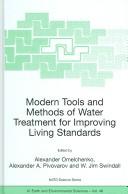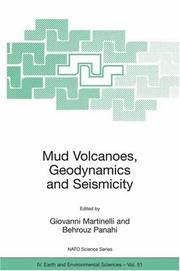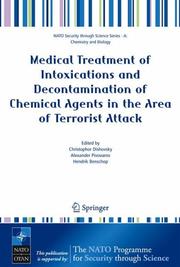| Listing 1 - 6 of 6 |
Sort by
|

ISBN: 9781402031168 Year: 2005 Publisher: Dordrecht Springer
Abstract | Keywords | Export | Availability | Bookmark
 Loading...
Loading...Choose an application
- Reference Manager
- EndNote
- RefWorks (Direct export to RefWorks)
General ecology and biosociology --- Hygiene. Public health. Protection --- Water supply. Water treatment. Water pollution --- Environmental protection. Environmental technology --- Production management --- Food science and technology --- voedingschemie --- voedingstechnologie --- gezondheidszorg --- waterverontreiniging --- ecologie --- milieuzorg --- kwaliteitscontrole --- milieubeheer --- milieuanalyse


ISBN: 1280283475 9786610283477 1402032048 1402032021 140203203X 9781402032028 9781402032042 Year: 2005 Volume: 48 Publisher: Dordrecht Brussels Springer NATO. Scientific Affairs Division
Abstract | Keywords | Export | Availability | Bookmark
 Loading...
Loading...Choose an application
- Reference Manager
- EndNote
- RefWorks (Direct export to RefWorks)
1. PURPOSE OF PRESENT BOOK During the period May 19-26, 2003 the NATO Advanced Research Workshop (ARW) “Mud volcanism, Geodynamics and Seismicity” was held in Baku. Participants coming from USA, Germany, France, Italy, Portugal, Russian Federation, Ukraine, Romania, Georgia, UK, Israel, Azerbaijan, Tunisia have discussed about different geodynamic features of mud volcanism and participated to field trips oriented to a better knowledge of mud volcanic features. The Meeting focused on many features of mud volcanism occurrence and related geodynamic topics. The purpose of present book is to collect contributions discussed during the Meeting and to fill a marked editorial gap on mud volcanism. Mud volcanism was to date described by local monographies or by articles published by scientific journals. In particular no books were published on topics able to highlight the link among mud volcanism, geodynamics and seismicity. Mud volcano of Nirano (Northern Italy). Engraving from Stoppani A. (1871), Corso di Geologia, Milan, Bernardoni G. and Brigola G. Publishers. 2. WHY MUD VOLCANOES ARE GEOLOGICALLY IMPORTANT ? Mud volcanoes have attracted the attention of earth scientists for many years. Due to their importance in hydrocarbon research, a consistent progress in the knowledge of mud volcanism took place in the past twenty years. Mud extrusion is a well-known phenomenon occurring in geological environments where fluid-rich, fine grained sediments ascend within a lithologic succession due to their buoyancy.
Mud volcanoes --- Seismology --- Hervidero --- Macaluba --- Volcanoes --- Salses --- Sismologie --- Congresses. --- Congrès --- EPUB-LIV-FT SPRINGER-B LIVTERRE --- Geography. --- Geochemistry. --- Physical geography. --- Hydraulic engineering. --- Mineral resources. --- Earth Sciences, general. --- Geophysics/Geodesy. --- Hydrogeology. --- Mineral Resources. --- Deposits, Mineral --- Mineral deposits --- Mineral resources --- Mines and mining --- Mining --- Natural resources --- Geology, Economic --- Minerals --- Engineering, Hydraulic --- Engineering --- Fluid mechanics --- Hydraulics --- Shore protection --- Geography --- Chemical composition of the earth --- Chemical geology --- Geological chemistry --- Geology, Chemical --- Chemistry --- Earth sciences --- Cosmography --- World history --- Earth sciences. --- Geophysics. --- Geohydrology --- Geology --- Hydrology --- Groundwater --- Geological physics --- Terrestrial physics --- Physics --- Geosciences --- Environmental sciences --- Physical sciences --- Geodynamics

ISBN: 9781402031168 Year: 2005 Publisher: Dordrecht Springer Netherlands
Abstract | Keywords | Export | Availability | Bookmark
 Loading...
Loading...Choose an application
- Reference Manager
- EndNote
- RefWorks (Direct export to RefWorks)
Providing the population of the Earth with safe drinking water is one of the biggest challenges of modern society. In recognition of this problem the United Nations Organization and UNESCO declared 2003 to be the International Year of Freshwater. On November 19-22, 2003, the NATO Advanced Research Workshop (ARW) on Modern Tools and Methods of Water Treatment for Improving Living Standards took place in Dnepropetrovsk, Ukraine. Thirty-one participants from 15 countries including Bulgaria, Canada, Croatia, Czech Republic, Denmark, Italy, Lithuania, Moldova, Poland, Romania, Russia, UK, Ukraine, USA, and Uzbekistan attended the meeting. They discussed the scientific concepts and practical means for the solution of the complex social, economic and ecological problems associated with water purification, consumption, conservation, and protection. They also established a network of scientists and specialists to foster further collaboration and the exchange of ideas. The location of the ARW was chosen quite deliberately. The city of Dnepropetrovsk is located on the banks of the Dnieper River and it has a population of about 1. 3 million people. As it is one of the largest industrial centers, it shares all the environmental problems, which are found in the modern Ukraine. In 2001, one in seven of the water samples taken from Ukrainian industrial and drinking water supply systems did not meet sanitary-hygienic standards, and one in twelve did not meet microbiological standards.
General ecology and biosociology --- Hygiene. Public health. Protection --- Water supply. Water treatment. Water pollution --- Environmental protection. Environmental technology --- Production management --- Food science and technology --- voedingschemie --- voedingstechnologie --- gezondheidszorg --- waterverontreiniging --- ecologie --- milieuzorg --- kwaliteitscontrole --- milieubeheer --- milieuanalyse

ISBN: 1402031149 1402031157 9786610283484 1280283483 1402031165 Year: 2005 Volume: 48 Publisher: Dordrecht ; New York : Springer,
Abstract | Keywords | Export | Availability | Bookmark
 Loading...
Loading...Choose an application
- Reference Manager
- EndNote
- RefWorks (Direct export to RefWorks)
Providing the population of the Earth with safe drinking water is one of the biggest challenges of modern society. In recognition of this problem the United Nations Organization and UNESCO declared 2003 to be the International Year of Freshwater. On November 19-22, 2003, the NATO Advanced Research Workshop (ARW) on “Modern Tools and Methods of Water Treatment for Improving Living Standards” took place in Dnepropetrovsk, Ukraine. Thirty-one participants from 15 countries including Bulgaria, Canada, Croatia, Czech Republic, Denmark, Italy, Lithuania, Moldova, Poland, Romania, Russia, UK, Ukraine, USA, and Uzbekistan attended the meeting. They discussed the scientific concepts and practical means for the solution of the complex social, economic and ecological problems associated with water purification, consumption, conservation, and protection. They also established a network of scientists and specialists to foster further collaboration and the exchange of ideas. The location of the ARW was chosen quite deliberately. The city of Dnepropetrovsk is located on the banks of the Dnieper River and it has a population of about 1. 3 million people. As it is one of the largest industrial centers, it shares all the environmental problems, which are found in the modern Ukraine. In 2001, one in seven of the water samples taken from Ukrainian industrial and drinking water supply systems did not meet sanitary-hygienic standards, and one in twelve did not meet microbiological standards.
Water --- Sewage --- Eau --- Eaux usées --- Purification. --- Epuration --- Purification --- Water. --- Civil & Environmental Engineering --- Engineering & Applied Sciences --- Environmental Engineering --- Eaux usées --- EPUB-LIV-FT LIVECOLO SPRINGER-B --- Environment. --- Water-supply. --- Chemistry. --- Medicine. --- Ecology. --- Quality control. --- Reliability. --- Industrial safety. --- Water pollution. --- Waste Water Technology / Water Pollution Control / Water Management / Aquatic Pollution. --- Water Industry/Water Technologies. --- Chemistry/Food Science, general. --- Medicine/Public Health, general. --- Quality Control, Reliability, Safety and Risk. --- Environmental pollution. --- System safety. --- Safety, System --- Safety of systems --- Systems safety --- Accidents --- Industrial safety --- Systems engineering --- Balance of nature --- Biology --- Bionomics --- Ecological processes --- Ecological science --- Ecological sciences --- Environment --- Environmental biology --- Oecology --- Environmental sciences --- Population biology --- Clinical sciences --- Medical profession --- Human biology --- Life sciences --- Medical sciences --- Pathology --- Physicians --- Physical sciences --- Chemical pollution --- Chemicals --- Contamination of environment --- Environmental pollution --- Pollution --- Contamination (Technology) --- Asbestos abatement --- Bioremediation --- Environmental engineering --- Environmental quality --- Factory and trade waste --- Hazardous waste site remediation --- Hazardous wastes --- In situ remediation --- Lead abatement --- Pollutants --- Refuse and refuse disposal --- Prevention --- Ecology --- Environmental aspects --- Health Workforce --- Ecology . --- Industrial accidents --- Industries --- Job safety --- Occupational hazards, Prevention of --- Occupational health and safety --- Occupational safety and health --- Prevention of industrial accidents --- Prevention of occupational hazards --- Safety, Industrial --- Safety engineering --- Safety measures --- Safety of workers --- System safety --- Dependability --- Trustworthiness --- Conduct of life --- Factory management --- Industrial engineering --- Reliability (Engineering) --- Sampling (Statistics) --- Standardization --- Quality assurance --- Quality of products --- Availability, Water --- Water availability --- Water resources --- Natural resources --- Public utilities --- Water resources development --- Water utilities --- Aquatic pollution --- Fresh water --- Fresh water pollution --- Freshwater pollution --- Inland water pollution --- Lake pollution --- Lakes --- Reservoirs --- River pollution --- Rivers --- Stream pollution --- Water contamination --- Water pollutants --- Water pollution --- Waste disposal in rivers, lakes, etc.
Book
ISBN: 9048123410 9048123429 9048123402 Year: 2009 Publisher: Dordrecht, Netherlands : Springer,
Abstract | Keywords | Export | Availability | Bookmark
 Loading...
Loading...Choose an application
- Reference Manager
- EndNote
- RefWorks (Direct export to RefWorks)
The terrorist act with sarin gas in the Tokyo underground and the case with the spread of anthrax spores through the U.S. postal system stimulated the development of orga- zation of fight against terrorism on a national and global level. The goal of this wo- shop was assessment of scientific concepts and practical means for management of chemical and biological agents casualties in the area of terrorist attacks with emphasis on improving the problems and situation in Eastern European Countries. In this book are included the results of both theoretical and practical research of chemical and biological terrorism presented during the workshop. Different trends of research to fight against terrorism on both local and governmental level including some Eastern European countries are discussed. The scientific articles are grouped into those areas: – New approaches in counteraction to chemical and biological terrorism – Medical treatment and decontamination of casualties from chemical and biological agents – Diagnosis of exposure to chemical and biological agents – Development of protection against injuries from chemical and biological agents In these articles the following are emphasized: – Some aspects of national and global defense against chemical and biological terrorism – National action plans and global agreements on combating terrorism – The characteristics of the major specific injuries connected with chemical and biological terrorism – Threats of terroristic attacks – Epidemiological and clinical peculiarities, ways of diagnosing, medical tre- ment and preventive health care measures These problems are analyzed from an interdisciplinary perspective.
Bioterrorism -- Europe, Eastern -- Prevention -- Congresses. --- Bioterrorism -- Health aspects. --- Chemical terrorism -- Europe, Eastern -- Prevention -- Congresses. --- Chemical terrorism -- Health aspects. --- Chemical terrorism --- Bioterrorism --- Chemical Terrorism --- Europe, Eastern --- Congresses --- Biological Warfare --- Terrorism --- Chemical Warfare --- Publication Formats --- Europe --- Publication Characteristics --- War --- Geographic Locations --- Violence --- Crime --- Social Problems --- Geographicals --- Sociology --- Criminology --- Social Sciences --- Anthropology, Education, Sociology and Social Phenomena --- Emergency Medical Services --- Criminology, Penology & Juvenile Delinquency --- Emergency Medicine --- Public Health --- Medicine --- Social Welfare & Social Work --- Health & Biological Sciences --- Prevention --- Prevention. --- Health aspects. --- Bio-terrorism --- Biological terrorism --- Law and legislation --- Medicine. --- Medical microbiology. --- Pharmacology. --- Chemistry. --- Emergency medicine. --- Medicine & Public Health. --- Emergency Medicine. --- Pharmacology/Toxicology. --- Chemistry/Food Science, general. --- Medicine/Public Health, general. --- Medical Microbiology. --- Medicine, Emergency --- Critical care medicine --- Disaster medicine --- Medical emergencies --- Physical sciences --- Drug effects --- Medical pharmacology --- Medical sciences --- Chemicals --- Chemotherapy --- Drugs --- Pharmacy --- Clinical sciences --- Medical profession --- Human biology --- Life sciences --- Pathology --- Physicians --- Physiological effect --- Toxicology. --- Microbiology. --- Microbial biology --- Biology --- Microorganisms --- Pharmacology --- Poisoning --- Poisons --- Toxicology --- Health Workforce


ISSN: 18714641 ISBN: 9781402041686 1402041683 1402041691 9786610427345 1280427345 1402041705 Year: 2006 Volume: v. 1 Publisher: Dordrecht, Netherlands : Springer,
Abstract | Keywords | Export | Availability | Bookmark
 Loading...
Loading...Choose an application
- Reference Manager
- EndNote
- RefWorks (Direct export to RefWorks)
This book includes reports which were presented at a NATO Advanced Research Workshop (ARW) entitled “Medical Treatment of Intoxications and Decontamination of Chemical Agent in the Area of Terrorist Attack”. The workshop was held on 25-28 January 2005 in Dnepropetrovsk, Ukraine. Currently, scientists and experts from many countries are working on development and implementation of a readiness for anti terrorist actions. In addition to chemical weapons, terrorists can use various toxic chemicals from chemical industry, agriculture or products released from terrorist acts on industrial facilities. The arsenal of chemical agents that can be used as terrorist agents is practically unlimited. The focus of this workshop was assessment of scientific concepts and practical means for management of chemical agent casualties in the area of terrorist attack with emphasis on improving the medical treatment and decontamination. These problems were analyzed from an interdisciplinary perspective. The primary objective of the ARW was to provide countries in which chemical-defense systems are currently under development with the experience and expertise of those that are more advanced and/or have already been exposed and responded to a chemical-terrorist attack. . The main areas covered were: 1. new approaches in pre-treatment and prophylaxis of nerve agent intoxication; 2. diagnosis of exposure to chemical agents ; 3. therapy of chemical agent intoxication; 4. development of personal decontamination; 5. decontamination of intoxication with chemical agents.
Victims of terrorism --- Chemical terrorism --- Chemical Terrorism --- Chemical Warfare --- Antidotes --- Chemical Warfare Agents --- Decontamination --- Medical care --- Congresses --- Health aspects --- prevention & control --- therapeutic use --- poisoning --- methods --- Chemical terrorism -- Health aspects -- Congresses. --- Electronic books. -- local. --- Victims of terrorism -- Medical care -- Congresses. --- Poisoning --- Methods --- Protective Agents --- Weapons of Mass Destruction --- Weapons --- Terrorism --- War --- Substance-Related Disorders --- Publication Formats --- Poisons --- Investigative Techniques --- Public Health Practice --- Publication Characteristics --- Manufactured Materials --- Physiological Effects of Drugs --- Diseases --- Public Health --- Noxae --- Specialty Uses of Chemicals --- Violence --- Analytical, Diagnostic and Therapeutic Techniques and Equipment --- Social Problems --- Crime --- Chemical Actions and Uses --- Sociology --- Pharmacologic Actions --- Environment and Public Health --- Technology, Industry, and Agriculture --- Toxic Actions --- Technology, Industry, Agriculture --- Health Care --- Social Sciences --- Criminology --- Chemicals and Drugs --- Anthropology, Education, Sociology and Social Phenomena --- Pharmacy, Therapeutics, & Pharmacology --- Emergency Medicine --- War & Public Health --- Medicine --- Health & Biological Sciences --- Terrorism victims --- Medicine. --- Pharmacology. --- Chemistry. --- Emergency medicine. --- Critical care medicine. --- Occupational medicine. --- Biomedicine. --- Pharmacology/Toxicology. --- Emergency Medicine. --- Occupational Medicine/Industrial Medicine. --- Intensive / Critical Care Medicine. --- Safety in Chemistry, Dangerous Goods. --- Victims of crimes --- Toxicology. --- Medicine, Industrial. --- Chemicals --- Safety measures. --- Intensive care --- Intensive medicine --- Emergency medicine --- Intensive care units --- Industrial medicine --- Medicine, Occupational --- Occupational medicine --- Occupational diseases --- Medicine, Emergency --- Critical care medicine --- Disaster medicine --- Medical emergencies --- Pharmacology --- Toxicology --- Physical sciences --- Drug effects --- Medical pharmacology --- Medical sciences --- Chemotherapy --- Drugs --- Pharmacy --- Physiological effect --- Medical treatment --- Intoxicants --- Terrorist attack
| Listing 1 - 6 of 6 |
Sort by
|

 Search
Search Feedback
Feedback About UniCat
About UniCat  Help
Help News
News